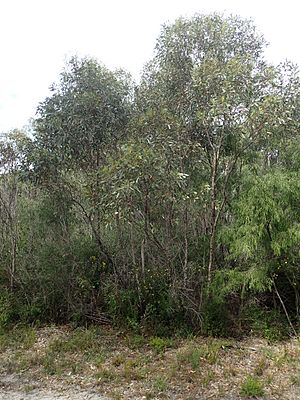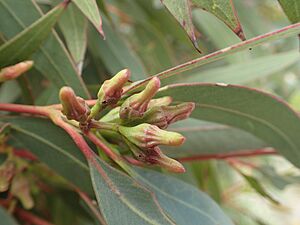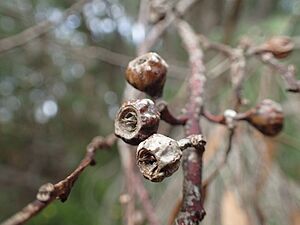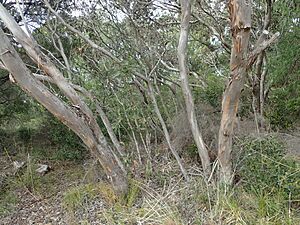Jerdacuttup mallee facts for kids
Quick facts for kids Jerdacuttup mallee |
|
|---|---|
 |
|
| Eucalyptus goniantha in Torndirrup National Park | |
| Scientific classification | |
| Genus: |
Eucalyptus
|
| Species: |
goniantha
|
| Synonyms | |
|
Eucalyptus incrassata var. goniantha (Turcz.) Maiden |
|
The Jerdacuttup mallee (scientific name: Eucalyptus goniantha) is a special type of plant. It's usually a mallee, which is a small, bushy tree, but sometimes it grows into a taller tree. You can only find it in Western Australia, which means it's endemic there. This plant has smooth bark, long, thin leaves, and pretty creamy-white flowers. Its flower buds grow in small groups, and its fruit looks like a round, ribbed capsule.
Contents
What the Jerdacuttup Mallee Looks Like
The Jerdacuttup mallee is usually a small, bushy tree, but it can sometimes grow taller. It typically reaches a height of about 1.5 to 10 meters (around 5 to 33 feet). This plant has smooth bark that can be grey or light brown. It also has a special woody swelling at its base called a lignotuber. This helps the plant regrow after fires.
Leaves and Flowers
Young Jerdacuttup mallee plants have leaves that are oblong (like a stretched oval) or even almost round. As the plant gets older, its adult leaves become lance-shaped. These leaves are about 8 to 13.5 centimeters (3 to 5 inches) long and 2 to 3.2 centimeters (about 1 inch) wide. They grow on a small stem called a petiole, which is about 1 to 2.3 centimeters long.
The flower buds of this plant grow in groups of seven, nine, or eleven. They are found where the leaves meet the stem, in an area called the axil. Each group of buds sits on a stem called a peduncle, which is about 1.1 to 1.5 centimeters long. Individual buds are on even smaller stems called pedicels, about 0.2 to 1 centimeter long.
When the buds are ready to open, they are oval-shaped and a creamy yellow color. They are about 0.8 to 1.1 centimeters long and 0.6 to 0.8 centimeters wide. Each bud has a rounded or slightly beaked cap, known as an operculum. The Jerdacuttup mallee mainly flowers from November to January. Its flowers are a lovely creamy white color.
Fruit
After flowering, the plant produces woody fruit. These fruits are shaped like a hemisphere (half a sphere) or a flattened sphere. They are about 0.7 to 1.1 centimeters long and 0.8 to 1.4 centimeters wide. The fruit often has strong or weak ribs on its surface. Inside, there are valves (parts that open) that stick out but are quite delicate.
Where the Jerdacuttup Mallee Lives
Both types (subspecies) of the Jerdacuttup mallee grow in places near the coast. They prefer thin, sandy soil, often found over limestone rocks.
Subspecies goniantha
The subspecies goniantha is found along the coast between Mutton Bird Island and the Flinders Peninsula, close to Albany. It can also be found a bit further inland, near Manypeaks. In some areas, it mixes with another type of plant called the Eucalyptus ecostata.
Subspecies kynoura
The subspecies kynoura is much rarer. It is only found in one specific spot called Point Hillier, which is near Denmark. Its name, kynoura, comes from a Greek word meaning "sea-cliff," which describes where this subspecies grows.
Protecting the Jerdacuttup Mallee
The Western Australian Government's Department of Parks and Wildlife keeps track of how many of these plants exist.
- The subspecies goniantha is considered "not threatened." This means there are enough of these plants, and they are not currently in danger.
- However, the subspecies kynoura is listed as "Priority Two." This means it is not very well known and is found in only one or a few locations. Because of this, it needs special attention to make sure it stays safe and doesn't become endangered.




